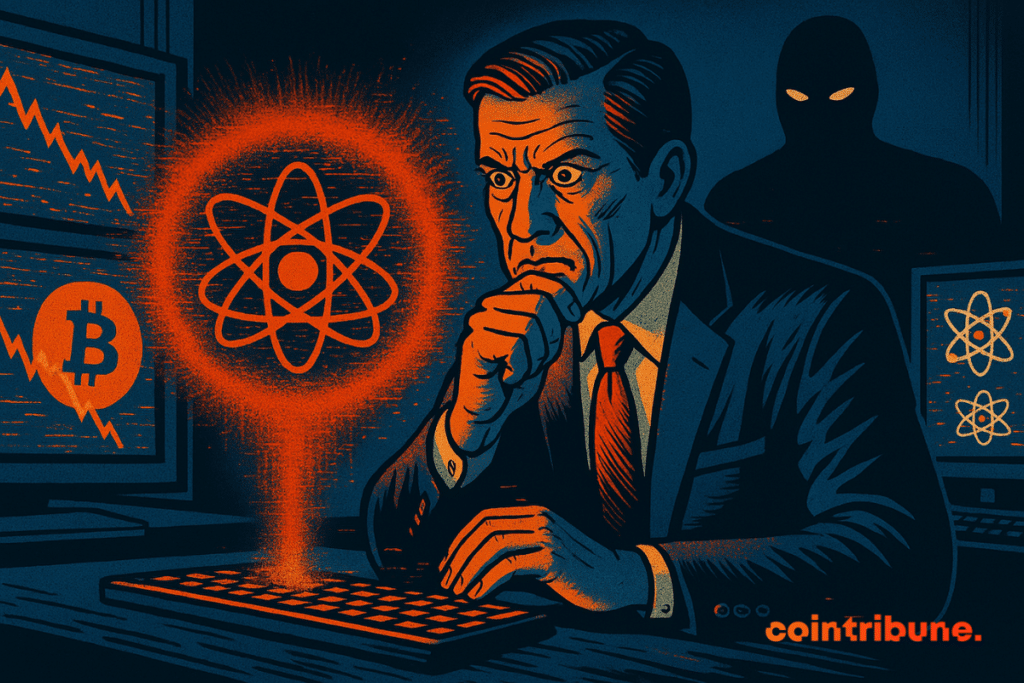Can Bitcoin Survive the Quantum Threat? BlackRock Has an Answer
Doubts are growing around the famous “Q-Day.” The day when quantum technology would surpass the cryptography protecting Bitcoin. This concern comes from BlackRock, which has explicitly mentioned the quantum risk in its Bitcoin ETF filing. This development raises a question: is Bitcoin’s security obsolete in the face of the power of future quantum computers? The stakes are huge, as it is not just a theoretical risk.

In Brief
- BlackRock lists the quantum risk for the first time in its Bitcoin ETF filing.
- 25% of bitcoins would be vulnerable in the event of a powerful quantum computer appearing.
- Google has developed a quantum processor capable of performing calculations impossible for classical supercomputers.
- Post-quantum solutions are already being tested to protect Bitcoin against this coming threat.
The Quantum Danger Looms Over Bitcoin
BlackRock, the asset management giant, has for the first time mentioned the threat of quantum computing in its updated prospectus for its Bitcoin ETF, iShares. This threat is based on a potential capability of quantum computers to decrypt the private keys securing Bitcoin transactions.
In its filing, BlackRock explains that:
If sufficiently powerful quantum processors emerge, they could decrypt private keys and compromise wallet security.
The firm also emphasizes that the transition to quantum-resistant cryptography would require broad consensus within the Bitcoin community. This shift to a new standard could be complex, even contentious.
Technically, the fear comes from the Shor’s algorithm, theoretically capable of breaking the elliptic curve cryptography on which the Bitcoin network relies. Google and Microsoft have presented quantum computing advancements, such as the Willow and Majorana 1 processors, capable of performing unimaginable calculations in minutes. Yet, reality is still far from an immediate threat.
As Paolo Ardoino, CEO of Tether, explains, “quantum machines are still far from being able to crack 256-bit security“, providing some breathing room.
However, according to analyses, nearly 25% of bitcoins in circulation are stored at potentially vulnerable addresses, especially those that have already revealed their public key. Should a sufficiently powerful quantum computer ever be developed, these coins would then be at risk.
Diverse Perspectives on the Quantum Threat
Opinions are divided in the crypto community. Some, like Coin Bureau, warn about the severity of the threat. Their tweet highlights:
The world’s largest asset manager, BlackRock, has just added quantum computing as a risk in its Bitcoin ETF filing.
This institutional warning is enough to increase attention.
Conversely, experts like Ole Lehmann take a more reassuring stance. They remind that Bitcoin anticipated this risk a long time ago. Ole writes: “Bitcoin isn’t afraid of Willow, Google’s quantum processor. Satoshi foresaw this threat 14 years ago.” He details that the Willow processor, though revolutionary, is just a first step in a long journey. To threaten Bitcoin, a technological leap of several orders would be required. Ole adds that:
Bitcoin developers are already working on post-quantum signatures, such as SPHINCS+, which will replace the old methods.
Moreover, the blockchain is not static. Recent forks, such as SegWit or Taproot, have already reinforced the network’s security and scalability. The community and developers demonstrate an adaptability that suggests a future with effective post-quantum protections.
Key Figures and Financial Stakes
Quantum represents a potential threat but also a significant economic challenge for Bitcoin and the crypto-sphere. Here are the key figures to remember:
- BlackRock’s Bitcoin iShares fund holds 64 billion dollars in net assets;
- About 25% of bitcoins (approximately 4 million) are in vulnerable addresses;
- Google announced a quantum processor capable of solving a problem in 5 minutes, compared to 10^25 years for classical supercomputers;
- Since the start of the year, Bitcoin ETFs have attracted more than 41 billion dollars, proof of strong interest despite the risks;
- Post-quantum signatures such as SPHINCS+ are already being tested on Bitcoin testnets.
This observation shows a contradiction: the market largely ignores the threat, focused on immediate volatility and growth, while the quantum threat calls for deep preparation. Furthermore, the transition to post-quantum cryptography could be laborious and divide the community.
In this race against time, some players also see quantum computing as an opportunity. For example, Naoris, specialized in cybersecurity, offers solutions to secure EVM-compatible blockchains without requiring a hard fork. This innovative approach offers extra comfort against future risks while maintaining network compatibility. Thus, the rise of quantum computing could stimulate a new generation of protections, combining enhanced security and technological continuity.
Maximize your Cointribune experience with our "Read to Earn" program! For every article you read, earn points and access exclusive rewards. Sign up now and start earning benefits.
La révolution blockchain et crypto est en marche ! Et le jour où les impacts se feront ressentir sur l’économie la plus vulnérable de ce Monde, contre toute espérance, je dirai que j’y étais pour quelque chose
The views, thoughts, and opinions expressed in this article belong solely to the author, and should not be taken as investment advice. Do your own research before taking any investment decisions.